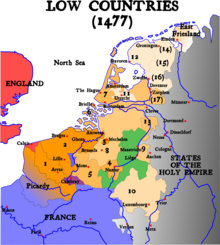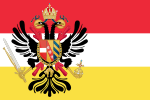Habsburg Netherlands
Habsburg Netherlands | |||||||||||||||
|---|---|---|---|---|---|---|---|---|---|---|---|---|---|---|---|
| 1482–1797 | |||||||||||||||

| |||||||||||||||
| Status | Personal union of Imperial fiefs within Empire | ||||||||||||||
| Capital | De facto: Mechelen till 1530, afterwards Brussels | ||||||||||||||
| Common languages | |||||||||||||||
| Religion |
| ||||||||||||||
| Government | Monarchy | ||||||||||||||
| Historical era | Early modern period | ||||||||||||||
• Inherited by House of Habsburg | 1482 | ||||||||||||||
• Incorporated into Burgundian Circle | 1512 | ||||||||||||||
| 1549 | |||||||||||||||
• Inherited by Habsburg Spain | 1556 | ||||||||||||||
| 30 January 1648 | |||||||||||||||
| 7 March 1714 | |||||||||||||||
| 18 September 1794 | |||||||||||||||
| 17 October 1797 | |||||||||||||||
| |||||||||||||||
Habsburg Netherlands[1] refers to those parts of the Low Countries that were ruled by sovereigns of the Holy Roman Empire's House of Habsburg.[2] This rule began in 1482 and ended for the Northern Netherlands in 1581 and for the Southern Netherlands in 1797. The rule began with the death in 1482 of Mary of Burgundy of the House of Valois-Burgundy who was the ruler of the Low Countries and the wife of Holy Roman Emperor Maximilian I of Austria.[3] Their grandson, Emperor Charles V, was born in the Habsburg Netherlands and made Brussels one of his capitals.[4][5]
Becoming known as the Seventeen Provinces in 1549, they were held by the Spanish branch of the Habsburgs from 1556, known as the Spanish Netherlands from that time on.[6] In 1581, in the midst of the Dutch Revolt, the Seven United Provinces seceded from the rest of this territory to form the Dutch Republic. The remaining Spanish Southern Netherlands became the Austrian Netherlands in 1714, after Austrian acquisition under the Treaty of Rastatt. De facto Habsburg rule ended with the annexation by the revolutionary French First Republic in 1795. Austria, however, did not relinquish its claim over the country until 1797 in the Treaty of Campo Formio.
Geography
[edit]The Habsburg Netherlands was a geo-political entity covering the whole of the Low Countries (i.e. the present-day Netherlands, Belgium, Luxembourg, and most of the modern French départements of Nord and Pas-de-Calais) from 1482 to 1581. The northern Low Countries began growing from 1200 CE, with the drainage and flood control of land, which could then be cultivated. The population rose and the region of Holland became important. Before that, the development of large cities was in the south, with Ghent, Bruges, Antwerp, Brussels, and Leuven, all of which were larger than any settlement in the north. Rivers in the Low Countries run east–west and were a political and strategic barrier to influence southern influence on the north, forming two separate political areas.[7]

Already under the Holy Roman Empire rule of the Burgundian duke Philip the Good (1419–1467), the provinces of the Netherlands began to grow together, whereas previously they were split with being either the tributary of the French Kingdom or of Burgundy under the Holy Roman Empire banner. The collected fiefdoms were Flanders, Artois and Mechelen, Namur, Holland, Zeeland and Hainaut, Brabant, Limburg, and Luxembourg. These realms were ruled in personal union by the Valois-Burgundy monarchs and represented in the States-General assembly. The centre of the Burgundian possessions was the Duchy of Brabant, where the Burgundian dukes held court in Brussels.
Philip's son Duke Charles the Bold (1467–1477) also acquired Guelders and Zutphen, and even hoped to gain the title of "King" from Habsburg emperor Frederick III by marrying his daughter Mary to Frederick's son Maximilian. Disappointed in this, he engaged in the disastrous Burgundian Wars and was killed in the Battle of Nancy.
History
[edit]
Upon the death of Mary of Burgundy in 1482, her substantial possessions including the Burgundian Netherlands passed to her son, Philip the Handsome, who married Joanna of Castile, daughter of Isabel I of Castile and Ferdinand II of Aragon. Through his father Maximilian I, Holy Roman Emperor, Philip was a Habsburg scion, and so the period of the Habsburg Netherlands began. The period 1481–1492 saw the Flemish cities revolt and Utrecht embroiled in civil war, but by the turn of the century both areas had been pacified by the Habsburg rulers.
Philip's son Charles, born in Ghent, succeeded his father as Duke in 1506, when he was six years old. His paternal grandfather, Emperor Maximilian I, incorporated the Burgundian heritage into the Burgundian Circle, whereafter the territories in the far west of the Empire developed a certain grade of autonomy. Through his mother Joanna, who had a mental breakdown following the death of her husband, he was heir to the Spanish kingdoms of Castile and Aragon and Spain's overseas empire in the New World. Attaining full age in 1515, Charles went on to rule his Burgundian heritage as a native Netherlander. He acquired the lands of Overijssel and the Bishopric of Utrecht (see Guelders Wars), purchased Friesland from Duke George of Saxony and regained Groningen and Gelderland. His Seventeen Provinces were re-organised in the Burgundian treaty of 1548, whereby the Imperial estates represented in the Imperial Diet at Augsburg acknowledged a certain autonomy of the Netherlands. It was followed by the Emperor's Pragmatic Sanction of 1549, which established the Seventeen Provinces as an entity held by a single prince.
Following a series of abdications between 1555 and 1556, Charles V divided the House of Habsburg into an Austrian-German and a Spanish branch. His brother Ferdinand I became suo jure monarch in Austria, Bohemia and Hungary, as well as the new Holy Roman Emperor. Philip II of Spain, Charles' son, inherited the Seventeen Provinces and incorporated them into the Spanish Crown (which included also south Italy and the American possessions). King Philip II of Spain became infamous for his despotism, and Catholic persecutions sparked the Dutch Revolt and the subsequent Eighty Years' War. The Spanish hold on the northern provinces was more and more tenuous. In 1579 the northern provinces established the Protestant Union of Utrecht, in which they declared themselves independent as the Seven United Provinces by the 1581 Act of Abjuration.
After the secession of 1581, the southern provinces, called "'t Hof van Brabant" (of Flandria, Artois, the Tournaisis, Cambrai, Luxembourg, Limburg, Hainaut, Namur, Mechelen, Brabant, and Upper Guelders) remained with the House of Habsburg until the French Revolutionary Wars. After the extinction of the Spanish Habsburg line in 1700 with the death of the childless Charles II and the War of the Spanish Succession (1700–14), the southern provinces were also known as the Austrian Netherlands from 1715 onwards.
Rulers
[edit]- 1482–1506 Philip I of Castile as Duke of Burgundy, Maximilian I, his father, as regent (1482–1493), Margaret of York, his stepgrandmother, governess (1489–1493)
- 1506–1556 Charles V as Duke of Burgundy, as Holy Roman Emperor from 1519.
- 1556–1581 Philip II as King of Spain
The provinces were ruled on their behalf by a governor (stadtholder or landvoogd):
- 1489–1493 Margaret of York, dowager Duchess of Burgundy
- 1506–1507 William de Croÿ, Marquis d'Aerschot
- 1507–1530 Margaret of Austria, Duchess of Savoy
- 1531–1555 Mary of Hungary
- 1555–1559 Emmanuel Philibert, Duke of Savoy
- 1559–1567 Margaret of Parma
- 1567–1573 Fernando Álvarez de Toledo, 3rd Duke of Alba
- 1573–1576 Luis de Requesens y Zúñiga
- 1576–1578 John of Austria
- 1578–1592 Alexander Farnese, Duke of Parma. In 1578, the Dutch insurgents appointed Archduke Matthias of Austria governor, though he could not prevail and resigned before the 1581 Act of Abjuration.
- 1685–1692 Francisco Antonio de Agurto Salcedo Medrano Zúñiga
Flag
[edit]During the Spanish period it is assumed that the flag was the Cross of Burgundy. After a period of turmoil with the Eighty Years' War, by 1713 the Southern Netherlands were separated from Spain and attached to Austria, assuming a flag consisting of three equal horizontal bands displaying the colours of red, white and gold. A small cross of Burgundy was present, which in 1781 was covered by a black double-headed eagle.
See also
[edit]References
[edit]- ^ (Dutch: Habsburgse Nederlanden; French: Pays-Bas des Habsbourg), in Latin referred to as Belgica
- ^ Erik Aerts, M. Baelde, Herman Coppens, H. De Schepper, Hugo Soly, Alfons K.L. Thijs, K. Van Honacker, De centrale overheidsinstellingen van de Habsburgse Nederlanden (1482-1795), Algemeen Rijksarchief, 1994
- ^ Sicking, L. H. J. (2004-01-01). Neptune and the Netherlands: State, Economy, and War at Sea in the Renaissance. BRILL. p. 13. ISBN 9004138501.
- ^ "How Brussels became the capital of Europe 500 years ago". The Brussels Times. 2017-04-21. Retrieved 2020-03-01.
- ^ Jenkins, Everett Jr. (2015-05-07). The Muslim Diaspora (Volume 2, 1500-1799): A Comprehensive Chronology of the Spread of Islam in Asia, Africa, Europe and the Americas. McFarland. p. 36. ISBN 978-1-4766-0889-1.
- ^ Kamen, Henry (2014-03-26). Spain, 1469–1714: A Society of Conflict. Routledge. ISBN 9781317755005.
- ^ Israel, Jonathan. The Dutch Republic, pp. 11-12
- Habsburg Netherlands
- History of the Low Countries
- Former polities in the Netherlands
- 15th century in Belgium
- 16th century in the Habsburg Netherlands
- 17th century in the Habsburg Netherlands
- 18th century in the Southern Netherlands
- States and territories established in 1482
- 1480s establishments in the Holy Roman Empire
- 1482 establishments in Europe
- States and territories disestablished in 1797




